1956 Poll 2.0
1956 Poll 2.0
Pick your favourite movies of 1956 (according to IMDB), up to 20 films.
20-film ballots must be ranked as follows (with point totals assigned):
Five tiers 5-4-3-2-1
Four tiers 4.5-3.5-2.5-1.5
Three tiers 5-3-1
Two tiers 4-2
One tier (aka unranked) 3
Ballot totals that aren't divisible by the number of tiers must be unranked. So 1, 3, 5, 7, 11, 13, 17, 19 film ballots are unranked.
20-film ballots must be ranked as follows (with point totals assigned):
Five tiers 5-4-3-2-1
Four tiers 4.5-3.5-2.5-1.5
Three tiers 5-3-1
Two tiers 4-2
One tier (aka unranked) 3
Ballot totals that aren't divisible by the number of tiers must be unranked. So 1, 3, 5, 7, 11, 13, 17, 19 film ballots are unranked.
Suzaki Paradise: Red Light District 1956 洲崎パラダイス 赤信号 Directed by Yūzō Kawashima
Flowing 1956 流れる Directed by Mikio Naruse
Yield to the Night 1956 Directed by J. Lee Thompson
The Forty-First 1956 Сорок первый Directed by Grigoriy Chukhray
Written on the Wind 1956 Directed by Douglas Sirk
There’s Always Tomorrow 1956 Directed by Douglas Sirk
On the Bowery 1956 Directed by Lionel Rogosin
The Wrong Man 1956 Directed by Alfred Hitchcock
The Searchers 1956 Directed by John Ford
Private Entrance 1956 Egen ingång Directed by Hasse Ekman
Slightly Scarlet 1956 Directed by Allan Dwan
7 Men from Now 1956 Directed by Budd Boetticher
Great Day in the Morning 1956 Directed by Jacques Tourneur
Nightfall 1956 Directed by Jacques Tourneur
Many Passed By 1956 Viele kamen vorbei Directed by Peter Pewas
The Wormwood Star 1956 Directed by Curtis Harrington
Baby Doll 1956 Directed by Elia Kazan
Night and Fog 1956 Nuit et Brouillard Directed by Alain Resnais
Water Light 1956 Directed by Lawrence Jordan
A Man Escaped 1956 Un condamné à mort s'est échappé Directed by Robert Bresson
Watchlist:
Night River 1956 夜の河 Directed by Kōzaburō Yoshimura
Flowing 1956 流れる Directed by Mikio Naruse
Yield to the Night 1956 Directed by J. Lee Thompson
The Forty-First 1956 Сорок первый Directed by Grigoriy Chukhray
Written on the Wind 1956 Directed by Douglas Sirk
There’s Always Tomorrow 1956 Directed by Douglas Sirk
On the Bowery 1956 Directed by Lionel Rogosin
The Wrong Man 1956 Directed by Alfred Hitchcock
The Searchers 1956 Directed by John Ford
Private Entrance 1956 Egen ingång Directed by Hasse Ekman
Slightly Scarlet 1956 Directed by Allan Dwan
7 Men from Now 1956 Directed by Budd Boetticher
Great Day in the Morning 1956 Directed by Jacques Tourneur
Nightfall 1956 Directed by Jacques Tourneur
Many Passed By 1956 Viele kamen vorbei Directed by Peter Pewas
The Wormwood Star 1956 Directed by Curtis Harrington
Baby Doll 1956 Directed by Elia Kazan
Night and Fog 1956 Nuit et Brouillard Directed by Alain Resnais
Water Light 1956 Directed by Lawrence Jordan
A Man Escaped 1956 Un condamné à mort s'est échappé Directed by Robert Bresson
Watchlist:
Night River 1956 夜の河 Directed by Kōzaburō Yoshimura
A year of masterpieces, especially from the Japanese. The final Mizoguchi? one of the most underrated Ozus? two top-tier Naruses - and a pretty good one for icing on the cake? As well as Yoshimura's gorgeous Night River, Toyoda's terrific Tanizaki adaptation, etc, etc. At present my top 20 would probably be:
A Man Escaped (Bresson)
The Searchers (Ford)
The Girl in Black (Kakogiannis)
Deadlier Than the Male (Duvivier)
Qivitoq (Balling)
Early Spring (Ozu)
Night River (Yoshimura)
Street of Shame (Mizoguchi)
Flowing (Naruse)
Sudden Rain (Naruse)
Merry-Go-Round (Fábri)
The Killing (Kubrick)
Suzaki Paradise (Kawashima)
The Railroad Man (Germi)
Shozo, a Cat, and Two Women (Toyoda)
The Ogre of Athens (Koundouros)
The Roof (de Sica)
Punishment Room (Ichikawa)
The Wrong Man (Hitchcock)
The Hidden One (Gavaldón)
A Man Escaped (Bresson)
The Searchers (Ford)
The Girl in Black (Kakogiannis)
Deadlier Than the Male (Duvivier)
Qivitoq (Balling)
Early Spring (Ozu)
Night River (Yoshimura)
Street of Shame (Mizoguchi)
Flowing (Naruse)
Sudden Rain (Naruse)
Merry-Go-Round (Fábri)
The Killing (Kubrick)
Suzaki Paradise (Kawashima)
The Railroad Man (Germi)
Shozo, a Cat, and Two Women (Toyoda)
The Ogre of Athens (Koundouros)
The Roof (de Sica)
Punishment Room (Ichikawa)
The Wrong Man (Hitchcock)
The Hidden One (Gavaldón)
How small of all that human hearts endure,
That part which laws or kings can cause or cure. - Johnson
That part which laws or kings can cause or cure. - Johnson
- St. Gloede
- Posts: 707
- Joined: Sat Feb 09, 2019 5:50 pm
My list: - I will keep an eye on other lists, but I don't think I'll watch as many new viewings as last month. Of course, if you know anything you think I'll love, shout it out.
Un condamné à mort s'est échappé / A Man Escaped (1956, Robert Bresson)
Bigger Than Life (1956, Nicholas Ray)
Akasen chitai / Street of Shame (1956, Kenji Mizoguchi)
Bob le flambeur (1956, Jean-Pierre Melville)
La Mort en ce jardin / Death in the Garden (1956, Luis Bunuel)
Neko to Shôzô to futari no onna / Shozo, a Cat and Two Women (1956, Shirô Toyoda)
The Wrong Man (1956, Alfred Hitchcock)
Aparajito / The Unvanquished (1956, Satyajit Ray)
Stríbrný vítr / Silvery Wind (1956, Václav Krska)
The Man Who Never Was (1956, Roland Neame)
Calle Mayor / Main Street (1956, Juan Antonio Bardem)
Trapeze (1956, Carol Reed)
Siraa Fil-Mina / Dark Waters (1956, Youssef Chahine)
Anastasia (1956, Anatole Litvak)
Friendly Persuasion (1956, William Wyler)
Mi tío Jacinto / Uncle Hyacint (1956, Ladislao Vajda)
Somebody Up There Likes Me (1956, Robert Ford)
Shokei no heya / Punishment Room (1956, Kon Ichikawa)
Shûu / Sudden Rain (1956, Mikio Naruse)
Körhinta / The Merry-Go-Round (1956, Zoltan Fabri)
Honourable mentions:
The Killing (1956, Stanley Kubrick)
Nagareru / Flowing (1956, Mikio Naruse)
Lust for Life (1956, Vincente Minnelli)
The Searchers (1956, John Ford)
Le mystère Picasso/ The Mystery of Picasso (1956, Henri-Georges Clouzot)
Otello (1956, Sergei Yutkevich)
Thunderstorm (1956, John Guillermin)
Giant (1956, George Stevens)
While the City Sleeps (1956, Fritz Lang)
Baby Doll (1956, Elia Kazan)
To koritsi me ta mavra / A Girl in Black (1956, Michael Cacoyannis)
The Harder They Fall (1956, Mark Robson)
Cien / Shadow (1956, Jerzy Kawalerowicz)
Tarde de toros / Afternoon of the Bulls (1956, Ladislao Vajda)
Voici le temps des assassins... / Deadlier Than the Male (1956, Julien Duvivier)
Los tallos amargos / The Bitter Stems (1956, Fernando Ayala)
Cela s'appelle l'aurore / That Is the Dawn (1956, Luis Bunuel)
Patterns (1956, Fielder Cook)
La sonate à Kreutzer (1956, Eric Rohmer)
Vesna na Zarechnoy ulitse / Spring on Zarechnaya Street (1956, Marlen Khutsiyev & Feliks Mironer)
Calabuch (1956 ,Luis García Berlanga)
I vampiri / Lust of the Vampire (1956, Riccardo Freda & Mario Bava)
Miyamoto Musashi kanketsuhen: kettô Ganryûjima / Samurai 3: Ketto Ganryujima (1956, Hiroshi Inagaki)
Gervaise (1956, René Clément)
Un condamné à mort s'est échappé / A Man Escaped (1956, Robert Bresson)
Bigger Than Life (1956, Nicholas Ray)
Akasen chitai / Street of Shame (1956, Kenji Mizoguchi)
Bob le flambeur (1956, Jean-Pierre Melville)
La Mort en ce jardin / Death in the Garden (1956, Luis Bunuel)
Neko to Shôzô to futari no onna / Shozo, a Cat and Two Women (1956, Shirô Toyoda)
The Wrong Man (1956, Alfred Hitchcock)
Aparajito / The Unvanquished (1956, Satyajit Ray)
Stríbrný vítr / Silvery Wind (1956, Václav Krska)
The Man Who Never Was (1956, Roland Neame)
Calle Mayor / Main Street (1956, Juan Antonio Bardem)
Trapeze (1956, Carol Reed)
Siraa Fil-Mina / Dark Waters (1956, Youssef Chahine)
Anastasia (1956, Anatole Litvak)
Friendly Persuasion (1956, William Wyler)
Mi tío Jacinto / Uncle Hyacint (1956, Ladislao Vajda)
Somebody Up There Likes Me (1956, Robert Ford)
Shokei no heya / Punishment Room (1956, Kon Ichikawa)
Shûu / Sudden Rain (1956, Mikio Naruse)
Körhinta / The Merry-Go-Round (1956, Zoltan Fabri)
Honourable mentions:
The Killing (1956, Stanley Kubrick)
Nagareru / Flowing (1956, Mikio Naruse)
Lust for Life (1956, Vincente Minnelli)
The Searchers (1956, John Ford)
Le mystère Picasso/ The Mystery of Picasso (1956, Henri-Georges Clouzot)
Otello (1956, Sergei Yutkevich)
Thunderstorm (1956, John Guillermin)
Giant (1956, George Stevens)
While the City Sleeps (1956, Fritz Lang)
Baby Doll (1956, Elia Kazan)
To koritsi me ta mavra / A Girl in Black (1956, Michael Cacoyannis)
The Harder They Fall (1956, Mark Robson)
Cien / Shadow (1956, Jerzy Kawalerowicz)
Tarde de toros / Afternoon of the Bulls (1956, Ladislao Vajda)
Voici le temps des assassins... / Deadlier Than the Male (1956, Julien Duvivier)
Los tallos amargos / The Bitter Stems (1956, Fernando Ayala)
Cela s'appelle l'aurore / That Is the Dawn (1956, Luis Bunuel)
Patterns (1956, Fielder Cook)
La sonate à Kreutzer (1956, Eric Rohmer)
Vesna na Zarechnoy ulitse / Spring on Zarechnaya Street (1956, Marlen Khutsiyev & Feliks Mironer)
Calabuch (1956 ,Luis García Berlanga)
I vampiri / Lust of the Vampire (1956, Riccardo Freda & Mario Bava)
Miyamoto Musashi kanketsuhen: kettô Ganryûjima / Samurai 3: Ketto Ganryujima (1956, Hiroshi Inagaki)
Gervaise (1956, René Clément)
Last edited by St. Gloede on Tue Jul 02, 2024 8:05 am, edited 1 time in total.
i seriously don't remember a thing about at least half the movies i logged for this year 
the ogre of athens - nikos koundouros
dark waters - youssef chahine
a man escaped - robert bresson
great day in the morning - jacques tourneur
child of sorrow - lamberto v. avellana
merry-go-round - zoltán fábri
professor hannibal - zoltán fábri
elena and her men - jean renoir
jagte raho - amit mitra, sombhu mitra
early spring - yasujirō ozu
street of shame - kenji mizoguchi
don't look back, my son - branko bauer
murderers and thieves - sacha guitry
sunday in peking - chris marker
together - lorenza mazzetti, denis horne
what a woman! - alessandro blasetti
the ogre of athens - nikos koundouros
dark waters - youssef chahine
a man escaped - robert bresson
great day in the morning - jacques tourneur
child of sorrow - lamberto v. avellana
merry-go-round - zoltán fábri
professor hannibal - zoltán fábri
elena and her men - jean renoir
jagte raho - amit mitra, sombhu mitra
early spring - yasujirō ozu
street of shame - kenji mizoguchi
don't look back, my son - branko bauer
murderers and thieves - sacha guitry
sunday in peking - chris marker
together - lorenza mazzetti, denis horne
what a woman! - alessandro blasetti
looks like there are a lot of things i still need to see from this year (merry go round, ogre of athens, and about a dozen japanese films, to start)
A Man Escaped (Robert Bresson)
Man From Del Rio (Harry Horner)
Star in the Dust (Charles Haas)
Professor Hannibal (Zoltan Fabri)
The Fastest Gun Alive (Russell Rouse)
Aparajito (Satyajit Ray)
The Harder They Fall (Mark Robson)
Somebody Up There Likes Me (Robert Wise)
Bob le Flambeur (Jean-Pierre Melville)
Street of Shame (Kenji Mizoguchi)
Attack (Robert Aldrich)
Seven Men From Now (Budd Boetticher)
Number 11: Mirror Animations (Harry Smith)
You Only Run Once (Felix Feist)
Time Table (Mark Stevens)
Forbidden Area (John Frankenheimer)
Wicked as They Come (Ken Hughes)
The Killing (Stanley Kubrick)
23 Paces from Baker Street (Henry Hathaway)
The Rawhide Years (Rudolph Mate)
A Man Escaped (Robert Bresson)
Man From Del Rio (Harry Horner)
Star in the Dust (Charles Haas)
Professor Hannibal (Zoltan Fabri)
The Fastest Gun Alive (Russell Rouse)
Aparajito (Satyajit Ray)
The Harder They Fall (Mark Robson)
Somebody Up There Likes Me (Robert Wise)
Bob le Flambeur (Jean-Pierre Melville)
Street of Shame (Kenji Mizoguchi)
Attack (Robert Aldrich)
Seven Men From Now (Budd Boetticher)
Number 11: Mirror Animations (Harry Smith)
You Only Run Once (Felix Feist)
Time Table (Mark Stevens)
Forbidden Area (John Frankenheimer)
Wicked as They Come (Ken Hughes)
The Killing (Stanley Kubrick)
23 Paces from Baker Street (Henry Hathaway)
The Rawhide Years (Rudolph Mate)
written on the wind
suzaki paradise
there's always tomorrow
seven men from now
early spring
nightfall
slightly scarlet
the searchers
ogre of athens
bigger than life
the man from del rio
on the bowery
flowing
quivitoq
invasion of the bodysnatchers
child of sorrow
merry go round
the harder they fall
the forty-first
great day in the morning
suzaki paradise
there's always tomorrow
seven men from now
early spring
nightfall
slightly scarlet
the searchers
ogre of athens
bigger than life
the man from del rio
on the bowery
flowing
quivitoq
invasion of the bodysnatchers
child of sorrow
merry go round
the harder they fall
the forty-first
great day in the morning
this is the good part; we can watch them all again
-
Lencho of the Apes
- Posts: 1881
- Joined: Tue Dec 11, 2018 4:38 am
I'll start with these:
Bigger Than Life
Invasion Of The Body Snatchers
La Herida Luminosa - Tulio Demicheli
A Man Escapes
Written On The Wind
Beyond A Reasonable Doubt
Horizontes De Piedra - Román Viñoly Barreto
Street Of Shame - Mizoguchi
While The City Sleeps
The Wrong Man
Attack - Aldrich
Death In The Garden - Bunuel
Jagte Raho - sorry, Sally.
The Ogre Of Athens
That Is The Dawn - Bunuel
Crazed Fruit
The Girl Can't Help It
The Killer Is Loose - Boetticher
The Man From Del Rio - Horner
El Rey De Mexico
Bigger Than Life
Invasion Of The Body Snatchers
La Herida Luminosa - Tulio Demicheli
A Man Escapes
Written On The Wind
Beyond A Reasonable Doubt
Horizontes De Piedra - Román Viñoly Barreto
Street Of Shame - Mizoguchi
While The City Sleeps
The Wrong Man
Attack - Aldrich
Death In The Garden - Bunuel
Jagte Raho - sorry, Sally.
The Ogre Of Athens
That Is The Dawn - Bunuel
Crazed Fruit
The Girl Can't Help It
The Killer Is Loose - Boetticher
The Man From Del Rio - Horner
El Rey De Mexico
The opposite of 'reify' is... ?
[provisional list deleted]
Last edited by Silga on Tue Jul 30, 2024 10:47 pm, edited 1 time in total.
another corman mini fest w featured star beverly garland!

gunslinger, it conquered the world and swamp women xD some people may have unfollowed me

gunslinger, it conquered the world and swamp women xD some people may have unfollowed me
Night River 1956 夜の河 Directed by Kōzaburō Yoshimura - This one storms into my list.
















jagte raho (mitras) - very cool movie, interesting structure and use of one location as the whole film is an extended chase scene. it is on the youtube
der hauptmann von köpenick (käutner) it's the anti-letzte mann. an ex-con cons the system. gentle humanist comedy ♥ both of these could make my list

also very poignant now the cult of military and police is ascendant again...
der hauptmann von köpenick (käutner) it's the anti-letzte mann. an ex-con cons the system. gentle humanist comedy ♥ both of these could make my list

also very poignant now the cult of military and police is ascendant again...
-
Lencho of the Apes
- Posts: 1881
- Joined: Tue Dec 11, 2018 4:38 am
Over Exposed - Lewis Seiter. Started out with a bang, real pronounced Barbara Payton(not B.M.)/Wicked Woman vibe in the beginning, and I thought "wait till Rischka and Evelyn (in particular) get a load of *this*!"
BUT
it didn't continue in that tone for long. Did other things that were different enough that I enjoyed it anyway... until it ended on such a brazen 'all she needed was a man!' note that I was disappointed.
BUT
it didn't continue in that tone for long. Did other things that were different enough that I enjoyed it anyway... until it ended on such a brazen 'all she needed was a man!' note that I was disappointed.
The opposite of 'reify' is... ?




beautifully mounted tale of madame white snake, directed by toyoda in japanese. it has the surreal feeling of prime HK cinema and is a shaw bros co-production!
gonna watch the other toyoda also. i loved this but ymmv this is sorta my jam
the other major hk/japanese co-production of the 50s is mizo's princess yang kwei-fei (1955)

shozo a cat and two women (toyoda) i could've enjoyed it more if we weren't on the point of putting women back in the position where their power is completely circumscribed by men.
i liked the cat and i prefer my cat to men
but hey it's 107 here today and we're all going to burn in a lake of fire. it's hard to have a sense of humor
Great movie that I too highly recommend. Yoshimura's other 1956, Wedding Day, I didn't like quite so much - could be I'm just dazzled by the color photography of Night River - though it's also very fine and may make its way onto the final list.
How small of all that human hearts endure,
That part which laws or kings can cause or cure. - Johnson
That part which laws or kings can cause or cure. - Johnson
- Monsieur Arkadin
- Posts: 412
- Joined: Mon May 27, 2019 5:56 pm
There's some confusion about Usmar Ismail's Tiga Dara. Which is 1956 on both Letterboxd and Imdb. But 1957 on Wikipedia. It is listed as both, at different points, 1956 & 1957 in the Bahasa Indonesia version of the article. I can read enough indonesian to parse through some of the sources, but many of them are in Dutch, which I'm useless for.
It seems to me that the film premiered in Indonesia in August 1956. The 1957 date comes from a Dutch article that came out a year later, around the time the film was exported to Europe. At this point I feel pretty confident that it was 1956. It was shot in March of 1956 and 5 months until release feels about correct for the pace Perfini was releasing films at that point. The company was in trouble, and this was a move away from neo-realism towards a Hollywood-style musical in the hopes of saving Perfini's long-term fiscal sustainability. So I also think, getting it released quickly would have been a priority.
I've dropped a file in the proper location if people are interested in it for this poll.
It seems to me that the film premiered in Indonesia in August 1956. The 1957 date comes from a Dutch article that came out a year later, around the time the film was exported to Europe. At this point I feel pretty confident that it was 1956. It was shot in March of 1956 and 5 months until release feels about correct for the pace Perfini was releasing films at that point. The company was in trouble, and this was a move away from neo-realism towards a Hollywood-style musical in the hopes of saving Perfini's long-term fiscal sustainability. So I also think, getting it released quickly would have been a priority.
I've dropped a file in the proper location if people are interested in it for this poll.
-
Lencho of the Apes
- Posts: 1881
- Joined: Tue Dec 11, 2018 4:38 am
Hey, remember Morris Engel/Ruth Orkin? The Little Fugitive? If anybody's deeply into that, they did a little-girl version in '56, called Lovers And Lollipops. NYC neorealism...
The opposite of 'reify' is... ?
- St. Gloede
- Posts: 707
- Joined: Sat Feb 09, 2019 5:50 pm
Seen 3 for this poll so far, and no standouts. The highlight has to be Three Women Around Yoshinaka by Teinosuke Kinugasa, best remembered for his silent, A Page of Madness (1926). It's a fairly drawn out samurai lord sage, of warring clans, and not too remarkable characters, though the battles themselves are often spectacular. There is a large battle about halfway in which avoids focusing on any characters, but instead obscures hordes of people rushing through trees, falling, dying, in almost minimalist mayhem. Some great, brutal shots. A polished and solid production, but it leaves a lot to be desired otherwise.
The big disappointment was Yûzô Kawashima's Hungry Soul. It is exposition-heavy, sports mostly flat dialogue, and feels visually bland, to the point that it reminded me of a TV movie (though perhaps from a few years later). The premise has something, but the film is so flat I just wanted it to be over. To be fair to Kawashima, he might just have been overworking himself, as I've seen 3 others of his released the same year, including the quite good Suzaki Paradise Red Light.
Between these two I also saw Ichikawa's first colour film Bridge of Japan, which I felt promised more in its opening in terms of atmosphere than it delivered. Perfectly well-made, but hardly memorable, and the Macedonian based-on-a-true story Cursed Money, which follows a bunch of farmers who become cut-throat big shots after finding out where the government stashed money during WW2. This one had a lot of promise, and is certainly memorable, but the presentation is a bit too ordinary. Still fun though.
The big disappointment was Yûzô Kawashima's Hungry Soul. It is exposition-heavy, sports mostly flat dialogue, and feels visually bland, to the point that it reminded me of a TV movie (though perhaps from a few years later). The premise has something, but the film is so flat I just wanted it to be over. To be fair to Kawashima, he might just have been overworking himself, as I've seen 3 others of his released the same year, including the quite good Suzaki Paradise Red Light.
Between these two I also saw Ichikawa's first colour film Bridge of Japan, which I felt promised more in its opening in terms of atmosphere than it delivered. Perfectly well-made, but hardly memorable, and the Macedonian based-on-a-true story Cursed Money, which follows a bunch of farmers who become cut-throat big shots after finding out where the government stashed money during WW2. This one had a lot of promise, and is certainly memorable, but the presentation is a bit too ordinary. Still fun though.
-
Mario Gaborovic
- Posts: 248
- Joined: Fri Jan 04, 2019 8:54 am
Cursed Money is Montenegrin, Gloede. I guess you mixed it up with Days of Temptation you watched the other day.St. Gloede wrote: ↑Mon Jul 08, 2024 10:10 pm Between these two I also saw Ichikawa's first colour film Bridge of Japan, which I felt promised more in its opening in terms of atmosphere than it delivered. Perfectly well-made, but hardly memorable, and the Macedonian based-on-a-true story Cursed Money, which follows a bunch of farmers who become cut-throat big shots after finding out where the government stashed money during WW2. This one had a lot of promise, and is certainly memorable, but the presentation is a bit too ordinary. Still fun though.
- St. Gloede
- Posts: 707
- Joined: Sat Feb 09, 2019 5:50 pm
Indeed, thanks.Mario Gaborovic wrote: ↑Thu Jul 11, 2024 7:39 pmCursed Money is Montenegrin, Gloede. I guess you mixed it up with Days of Temptation you watched the other day.St. Gloede wrote: ↑Mon Jul 08, 2024 10:10 pm Between these two I also saw Ichikawa's first colour film Bridge of Japan, which I felt promised more in its opening in terms of atmosphere than it delivered. Perfectly well-made, but hardly memorable, and the Macedonian based-on-a-true story Cursed Money, which follows a bunch of farmers who become cut-throat big shots after finding out where the government stashed money during WW2. This one had a lot of promise, and is certainly memorable, but the presentation is a bit too ordinary. Still fun though.
i watched kawashima's other '56 our town - where a 'loveable' asshole tries to ruin the lives of everyone around him because patriarchy. hard pass
but credit to the director that i didn't turn it off
but credit to the director that i didn't turn it off
- der kulterer
- Posts: 3126
- Joined: Sat Sep 05, 2020 12:30 am
- Location: Prague, Bohemia
SILVERY WIND (Václav Krška)
finished in 1954
kept under the ban by censors for 2 years
released in 1956
preliminary side note:
all said below is (mostly) based on reading two texts (in Czech) ↓↓
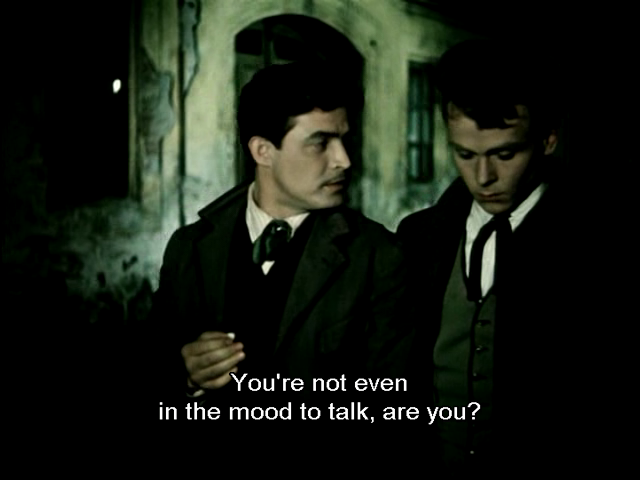
1/
EVERYTHING IS BEAUTIFUL (BETWEEN US GUYS) / QUEER ASPECTS OF VÁCLAV KRŠKA'S FILMS
VŠECHNO JE KRÁSNÉ (MEZI NÁMI KLUKY) / QUEER ASPEKTY FILMŮ VÁCLAVA KRŠKY
(by Lukáš Skupa, article in CINEPUR, No. 71, September 2010)
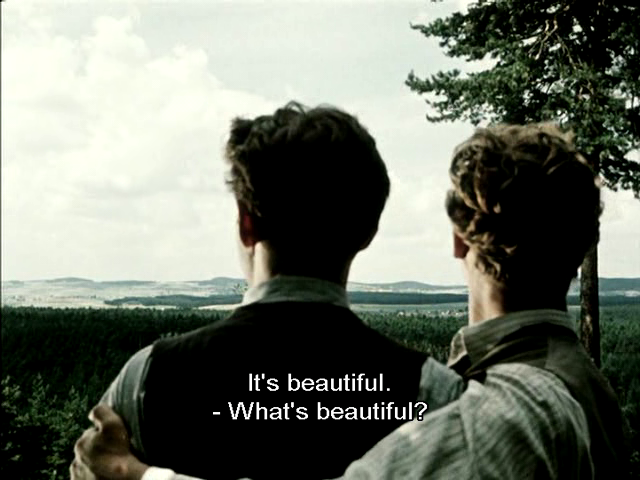
2/
THE SECRET WAS IN HIS EYES: EDUARD CUPÁK / THE BIRTH OF A QUEER ICON IN CZECHOSLOVAK CINEMA OF THE 1950s
TO TAJEMSTVÍ BYLO V JEHO OČÍCH: EDUARD CUPÁK / ZROZENÍ QUEER IKONY V ČESKOSLOVENSKÉ KINEMATOGRAFII 50. LET
(by Jan Bodnár, bachelor thesis, 2015)
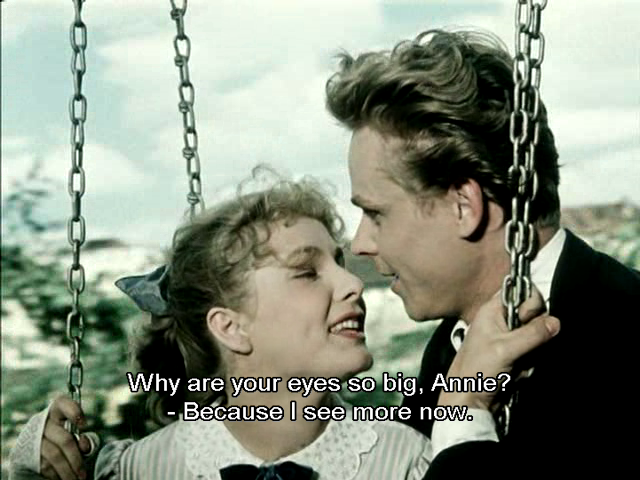
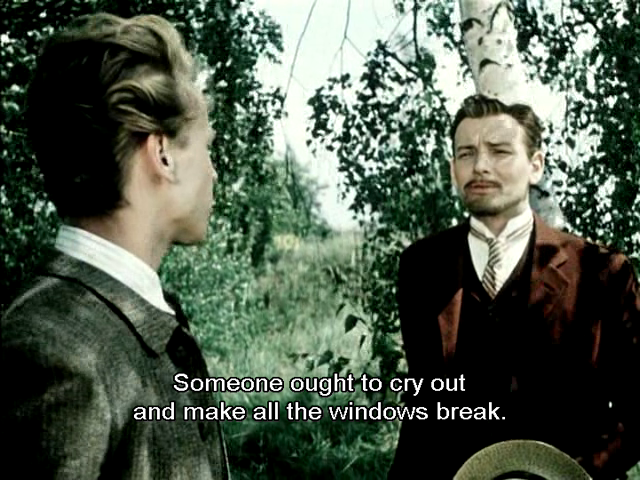
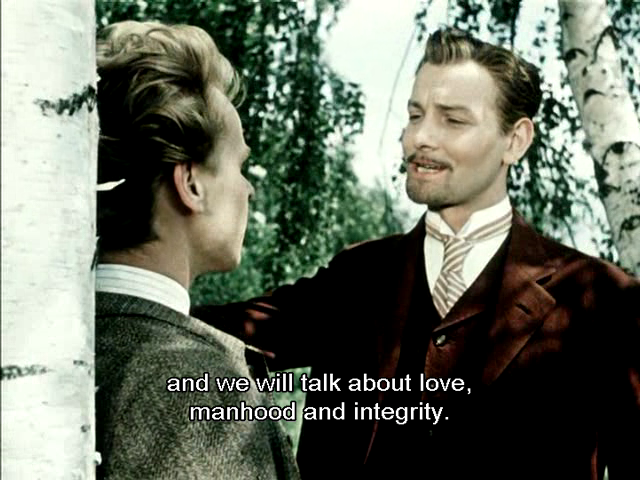
pre-WW2, the Prague artistic queer community was centered around Miloš Havel (uncle of the later president Václav Havel), the owner of Barrandov Studios and Lucernafilm production company
→ https://en.wikipedia.org/wiki/Milo%C5%A1_Havel
young film directors František Čáp and Václav Krška (who made together for Lucernafilm FIERY SUMMER in 1939) were part of this milieu.
the most iconic actor (& gay) of the time was an eccentric Eduard Kohout
→ https://letterboxd.com/actor/eduard-kohout/
after WW-2, Barrandov Studios were nationalized, Miloš Havel and František Čáp went into exile.
thus the director Václav Krška and his young acting star (SILVERY WIND was his iconic-status-breakthrough) Euduard Cupák became the new queer epicenter (including the other gays who collaborated on the SILVERY WIND — assistant director Jaroslav Beránek, costume designer Fernand Vácha).
post-WW2 Czechoslovakia, following the example of the Stalinist Soviet Union, considered homosexuality a bourgeois deviation.
thus with the advent of socialism (and eradication of all the bourgeois), homosexuality became "non-existent" (tho the bourgeois law of prosecuting homosexuality was still in action throughout the 1950s).
partial decriminalization of homosexuality happened in Czechoslovakia in 1961, thanks to the lobbying of the sexologists led by Kurt Freund
→ https://en.wikipedia.org/wiki/Kurt_Freund
this "offense" is only no longer submitted to a state penal bureaucracy but instead to the newly established (self-regulatory) "local people's courts" — something (fortunately enough) rather unfunctional in the local Kafkesque penal system and thus local gays and lesbians (including the artistic queer community of Václav Krška & Eduard Cupák) could (since 1961) relatively freely display their "bourgeois pathology" without prosecution.
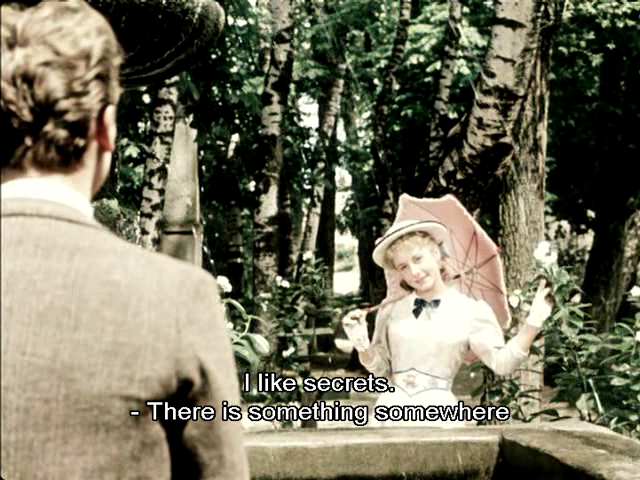
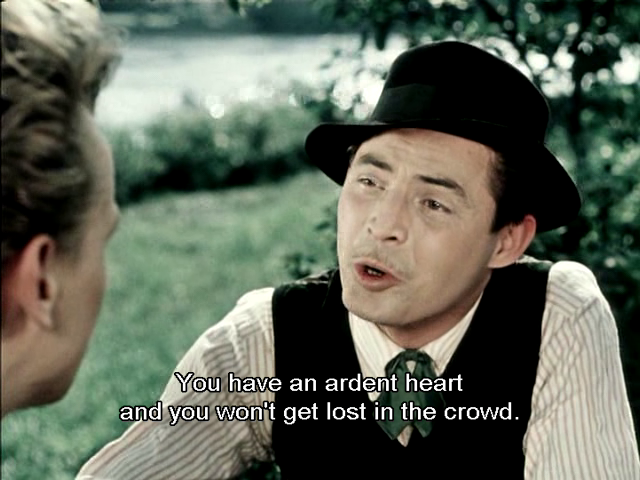
thus we don't see in 1950s Czechoslovak films gay or lesbian characters.
there are only these "strange" Václav Krška's (or exiled František Čáp's) movies where behind the thin facade of the heteronormative plot is happening something that allows — more (Krška) or less (Čáp) clear — queer reading.
thus even if the male characters are staged as voyeurs of the female body (a typical heteronormative male gaze) those same male characters (their bodies, their facial expressions, their physical interactions) can become the subject of meta-voyeurism of the (eventually queer) audience (watching the film).
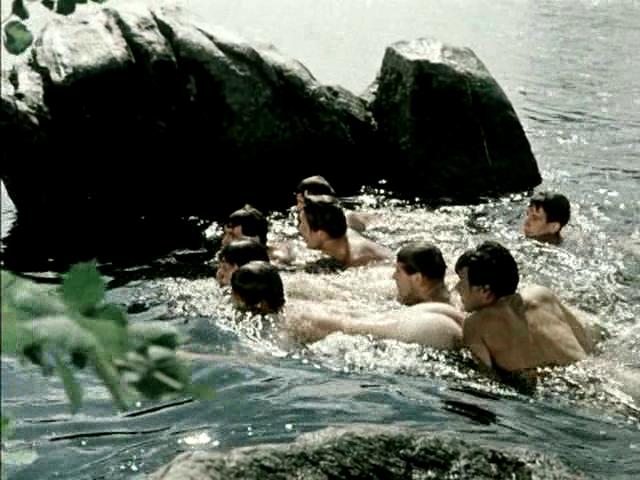
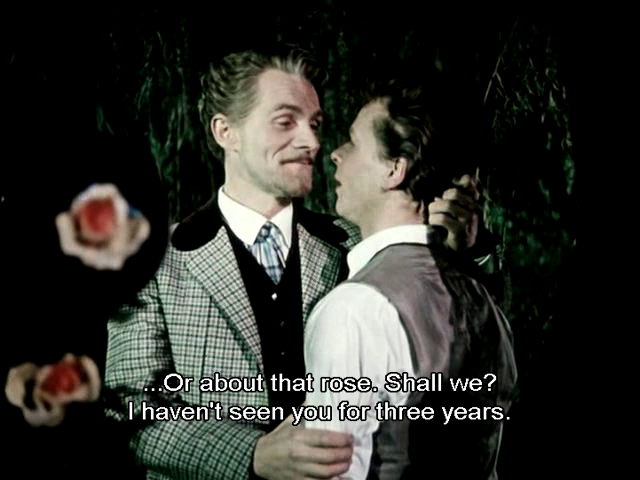
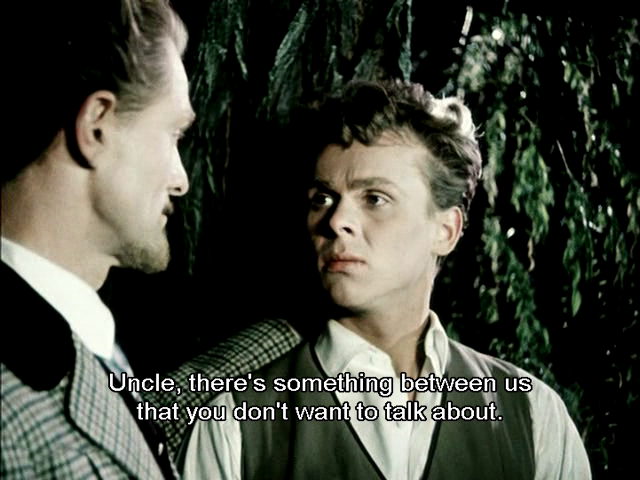
unfortunately, this situation on screen didn't change for the better in the 1960s (despite the overall liberalization and advent of the Czech New Wave).
gay or lesbian characters start to appear in films but either as mentally disturbed (gay inmate of the psychiatric hospital who later commits suicide in THE RETURN OF THE PRODIGAL SON (1967) by Evald Schorm), or as laughable caricatures (gay in HOTEL FOR STRANGERS (1967) by Antonín Máša).
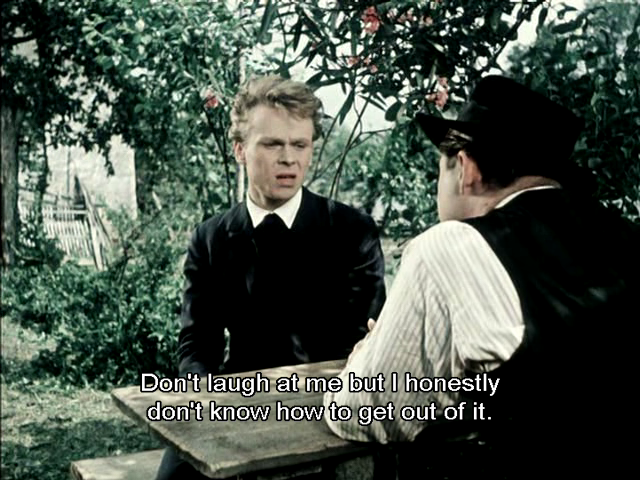
at best, Ladislav Helge comes in CHANCE MEETING (1965) with something similar to Václav Krška — with an outwardly heteronormative plot that allows queer reading.
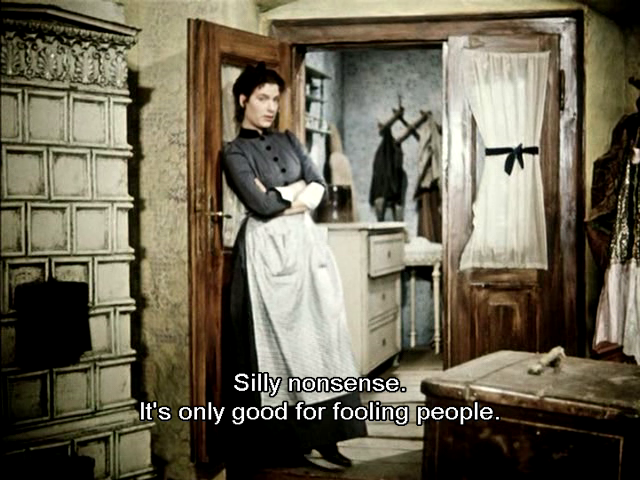
this deplorable situation didn't change till the end of the (conservative) communist regime.
in 1989, the Czech New Wave icon Věra Chytilová is still staging (A HOOF HERE, A HOOF THERE) a gay character as a comical figure.
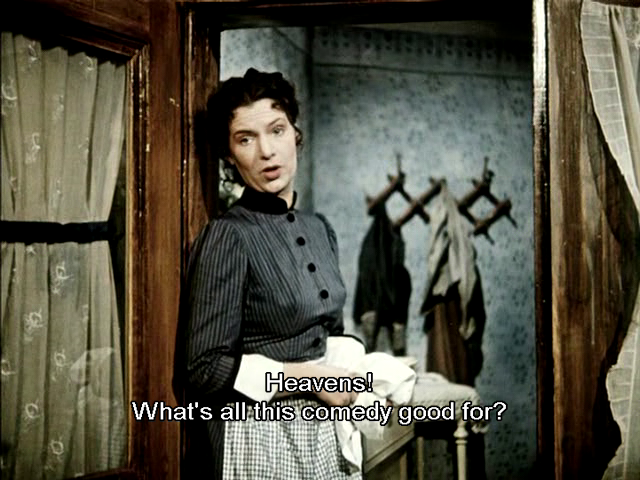
anyway, back to the film in question (i.e. SILVERY WIND)...

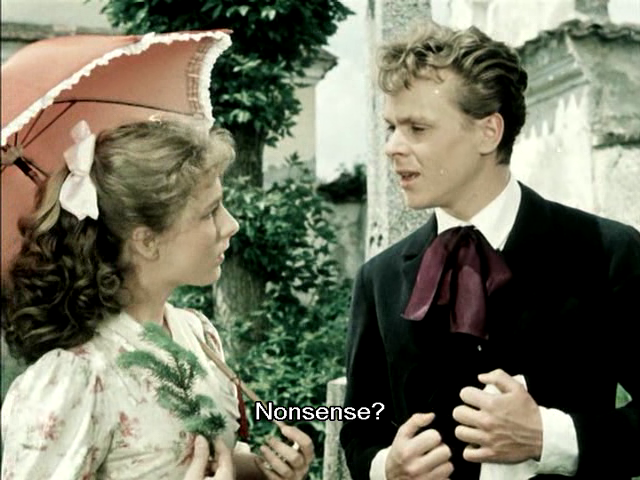
it is based on a novel (published in 1910) by Fráňa Šrámek (1877-1952) — an anarchist, pacifist, and vitalist (celebration of life and nature) poet.
he was an Oscar-Wilde-type of rebel, revolting against the bourgeois society of his time — thus appealing to Václav Krška (his MOON OVER THE RIVER, 1953 is also an adaptation of Fráňa Šrámek), and somehow also an acceptable author for the communists (considered to be an anarchist forerunner to communism — despite he never joined Communist Party).
the plot takes place in the second half of the 19th century and costume stylization refers to the outfits of a Victorian dandy (contribution by the aforementioned gay costume designer Fernand Vácha).
SILVERY WIND is also unique by re-introducing a romantic hero (a lover) on the Czechoslovak screen.
this type of character wasn't unusual in pre-WW2 Czechoslovak genre films (melodramas).
with the advent of communism & socialist realism, melodrama was labeled as petit bourgeois rubbish and a delirious romantic lover disappeared from the screen — making room for a worker who is (instead of womanizing) sweating in the factory to build a bright totalitarian future.
poor delirious romantic lover survives only in fairy tales (as a "prince" character).
Václav Krška not only fancied casting all those "princes" in his films...
Vladimír Ráž:
1/ prince Miroslav in THE PROUD PRINCESS (Bořivoj Zeman, 1952)
2/ Prof. Luděk Ramler in SILVERY WIND


... but in SILVERY WIND he put back on screen the pre-WW2 type of melodrama lover (viz Eduard Cupák gaining an iconic status) who passionately chases "silvery wind" wherever it takes him.
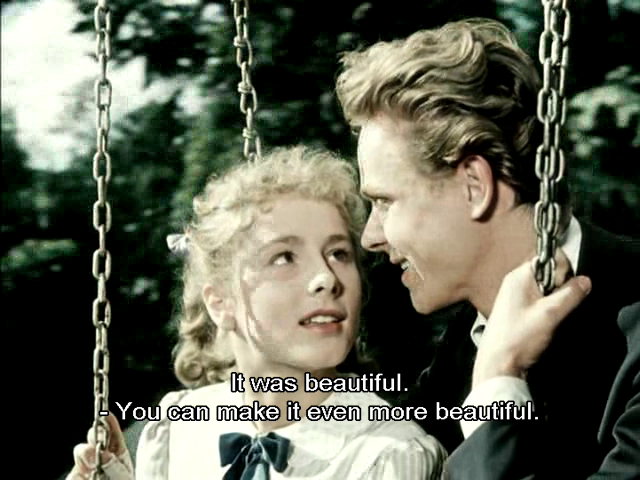
finished in 1954
kept under the ban by censors for 2 years
released in 1956
preliminary side note:
all said below is (mostly) based on reading two texts (in Czech) ↓↓

1/
EVERYTHING IS BEAUTIFUL (BETWEEN US GUYS) / QUEER ASPECTS OF VÁCLAV KRŠKA'S FILMS
VŠECHNO JE KRÁSNÉ (MEZI NÁMI KLUKY) / QUEER ASPEKTY FILMŮ VÁCLAVA KRŠKY
(by Lukáš Skupa, article in CINEPUR, No. 71, September 2010)

2/
THE SECRET WAS IN HIS EYES: EDUARD CUPÁK / THE BIRTH OF A QUEER ICON IN CZECHOSLOVAK CINEMA OF THE 1950s
TO TAJEMSTVÍ BYLO V JEHO OČÍCH: EDUARD CUPÁK / ZROZENÍ QUEER IKONY V ČESKOSLOVENSKÉ KINEMATOGRAFII 50. LET
(by Jan Bodnár, bachelor thesis, 2015)

so, where to start... (???)Abstract:
This thesis is about the birth of a queer movie icon Eduard Cupák in Czechoslovakia in the 50´s.
Gay director and gay actor duo is unique in our cinema. In order to understand the modes of such production and creative collaboration, I worked with information collected from interviews with people from this era and people who knew Cupák — mostly friends and colleges.


pre-WW2, the Prague artistic queer community was centered around Miloš Havel (uncle of the later president Václav Havel), the owner of Barrandov Studios and Lucernafilm production company
→ https://en.wikipedia.org/wiki/Milo%C5%A1_Havel
young film directors František Čáp and Václav Krška (who made together for Lucernafilm FIERY SUMMER in 1939) were part of this milieu.
the most iconic actor (& gay) of the time was an eccentric Eduard Kohout
→ https://letterboxd.com/actor/eduard-kohout/
after WW-2, Barrandov Studios were nationalized, Miloš Havel and František Čáp went into exile.
thus the director Václav Krška and his young acting star (SILVERY WIND was his iconic-status-breakthrough) Euduard Cupák became the new queer epicenter (including the other gays who collaborated on the SILVERY WIND — assistant director Jaroslav Beránek, costume designer Fernand Vácha).
post-WW2 Czechoslovakia, following the example of the Stalinist Soviet Union, considered homosexuality a bourgeois deviation.
thus with the advent of socialism (and eradication of all the bourgeois), homosexuality became "non-existent" (tho the bourgeois law of prosecuting homosexuality was still in action throughout the 1950s).
partial decriminalization of homosexuality happened in Czechoslovakia in 1961, thanks to the lobbying of the sexologists led by Kurt Freund
→ https://en.wikipedia.org/wiki/Kurt_Freund
decriminalization (of 1961) was only partial because homosexual behavior was still seen as "illegitimate".Between 1950 and 1953, Freund treated 67 men for homosexual tendencies.
Some of his patients voluntarily sought to change their sexual orientation, while others received remission of prosecution or legal penalties so that they could undergo the experiment. Taking a behaviorist perspective, he attempted to reinforce heterosexual feelings while punishing homosexual ones in order to change sexual orientation. Patients were given nausea-inducing drugs while exposed to images of other men, then given testosterone injections and exposed to photographs of naked women.
Freund followed up with his patients in 1956 and 1958, concluding that the experiment was not a success. His empirical data showed some of the first evidence that sexual orientation conversion therapy was generally futile. He demonstrated that even homosexually oriented men who appeared to have given up sexual relations with other men and established heterosexual marriages were still aroused by images of men rather than women. Freund also challenged contemporary psychoanalytic theories of male homosexuality that suggested it was due to a fear or aversion to women.
In 1957, he began to advocate for the decriminalization of homosexuality, which happened in Czechoslovakia in 1961 following an official recommendation signed by Freund and other psychiatrists. Like other researchers at the time, however, he continued to see homosexuality as a pathology. In 1977, he apologized for his attempt to change sexual orientation, writing that if his experiment "has 'helped' at all, has helped clients to enter into marriages that later became unbearable or almost unbearable" and expressing doubt that homosexuality should be considered an illness because of the chance that "reasonable social changes may virtually abolish all specific distress of homosexual persons". Freund advised his patients to make peace with their sexual orientation.
this "offense" is only no longer submitted to a state penal bureaucracy but instead to the newly established (self-regulatory) "local people's courts" — something (fortunately enough) rather unfunctional in the local Kafkesque penal system and thus local gays and lesbians (including the artistic queer community of Václav Krška & Eduard Cupák) could (since 1961) relatively freely display their "bourgeois pathology" without prosecution.


thus we don't see in 1950s Czechoslovak films gay or lesbian characters.
there are only these "strange" Václav Krška's (or exiled František Čáp's) movies where behind the thin facade of the heteronormative plot is happening something that allows — more (Krška) or less (Čáp) clear — queer reading.
thus even if the male characters are staged as voyeurs of the female body (a typical heteronormative male gaze) those same male characters (their bodies, their facial expressions, their physical interactions) can become the subject of meta-voyeurism of the (eventually queer) audience (watching the film).



unfortunately, this situation on screen didn't change for the better in the 1960s (despite the overall liberalization and advent of the Czech New Wave).
gay or lesbian characters start to appear in films but either as mentally disturbed (gay inmate of the psychiatric hospital who later commits suicide in THE RETURN OF THE PRODIGAL SON (1967) by Evald Schorm), or as laughable caricatures (gay in HOTEL FOR STRANGERS (1967) by Antonín Máša).

at best, Ladislav Helge comes in CHANCE MEETING (1965) with something similar to Václav Krška — with an outwardly heteronormative plot that allows queer reading.

this deplorable situation didn't change till the end of the (conservative) communist regime.
in 1989, the Czech New Wave icon Věra Chytilová is still staging (A HOOF HERE, A HOOF THERE) a gay character as a comical figure.

anyway, back to the film in question (i.e. SILVERY WIND)...


it is based on a novel (published in 1910) by Fráňa Šrámek (1877-1952) — an anarchist, pacifist, and vitalist (celebration of life and nature) poet.
he was an Oscar-Wilde-type of rebel, revolting against the bourgeois society of his time — thus appealing to Václav Krška (his MOON OVER THE RIVER, 1953 is also an adaptation of Fráňa Šrámek), and somehow also an acceptable author for the communists (considered to be an anarchist forerunner to communism — despite he never joined Communist Party).
the plot takes place in the second half of the 19th century and costume stylization refers to the outfits of a Victorian dandy (contribution by the aforementioned gay costume designer Fernand Vácha).
SILVERY WIND is also unique by re-introducing a romantic hero (a lover) on the Czechoslovak screen.
this type of character wasn't unusual in pre-WW2 Czechoslovak genre films (melodramas).
with the advent of communism & socialist realism, melodrama was labeled as petit bourgeois rubbish and a delirious romantic lover disappeared from the screen — making room for a worker who is (instead of womanizing) sweating in the factory to build a bright totalitarian future.
poor delirious romantic lover survives only in fairy tales (as a "prince" character).
Václav Krška not only fancied casting all those "princes" in his films...
Vladimír Ráž:
1/ prince Miroslav in THE PROUD PRINCESS (Bořivoj Zeman, 1952)
2/ Prof. Luděk Ramler in SILVERY WIND


... but in SILVERY WIND he put back on screen the pre-WW2 type of melodrama lover (viz Eduard Cupák gaining an iconic status) who passionately chases "silvery wind" wherever it takes him.

thx for all this jiri, i'm gonna watch it today 
- der kulterer
- Posts: 3126
- Joined: Sat Sep 05, 2020 12:30 am
- Location: Prague, Bohemia
I love it  it is the perfect thing to distract me too
it is the perfect thing to distract me too 
it's beautiful
it's beautiful
- der kulterer
- Posts: 3126
- Joined: Sat Sep 05, 2020 12:30 am
- Location: Prague, Bohemia
KG MUTHAFUCKERS are deluded.
here you are safe!
- Evelyn Library P.I.
- Posts: 1358
- Joined: Thu Dec 20, 2018 10:36 pm
Marie-Antoinette, reine de france (Jean Delannoy)
A textbook example of the tradition de la qualitie that Truffaut opposed in his famous '54 article. It's far more artistically interesting than the Cahiers crowd would have you believe. It's well-staged by Delannoy; the visuals are clearly and appropriately drawn after the model of French neoclassical painting, which was current in the second half of the eighteenth century when the film is set.
The She-Creature (Edward L. Cahn)
Chester Morris hypnotizes Marla English recalling—and reviving!— her past life as a sea monster, with Tom Conway treating it as a Falcon mystery and El Brendel resurrecting his Swedish immigrant vaudeville act. Very weird, very dopey. The good stuff.
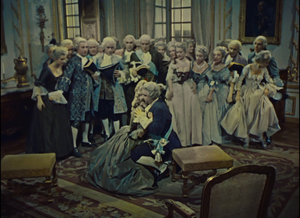
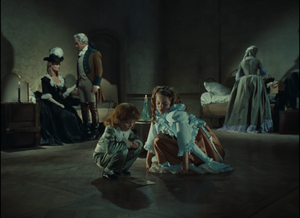
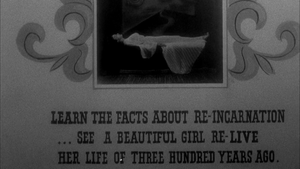
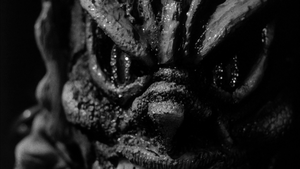
A textbook example of the tradition de la qualitie that Truffaut opposed in his famous '54 article. It's far more artistically interesting than the Cahiers crowd would have you believe. It's well-staged by Delannoy; the visuals are clearly and appropriately drawn after the model of French neoclassical painting, which was current in the second half of the eighteenth century when the film is set.
The She-Creature (Edward L. Cahn)
Chester Morris hypnotizes Marla English recalling—and reviving!— her past life as a sea monster, with Tom Conway treating it as a Falcon mystery and El Brendel resurrecting his Swedish immigrant vaudeville act. Very weird, very dopey. The good stuff.




she-creature was fun! i rewatched bodysnatchers cuz that's how i feel right now

also graciela, argentine gothic melodrama

watching elena et les hommes and it's colorful!


also graciela, argentine gothic melodrama

watching elena et les hommes and it's colorful!







